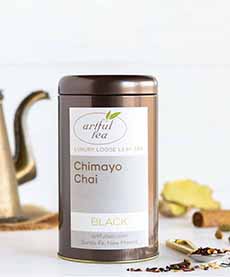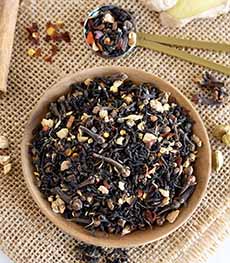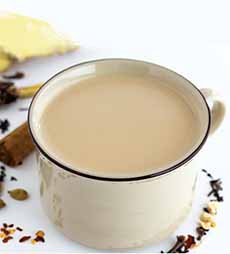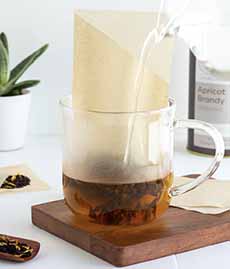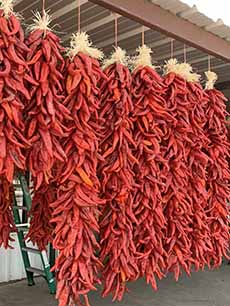Southwestern Chai: Spicy Chai With New Mexico Chimayo Chiles
|
Since the early 1900s, the British-owned Indian Tea Association began to promote their version of chai—which began as an ancient ayurvedic beverage of a mixture of spices and herbs called masala, brewed in water. The origins of that beverage can be traced back 5,000 years, when Indian emperors drank a caffeine-free spiced drink to stay alert in court. Called kadha, it was made with Ayurvedic spices and was meant to heal and cleanse the body. It became used in general for medicinal purposes. The masala chai we know today took another few millennia to arrive. When the British East India Company, concerned about the Chinese monopoly on tea, arrived in India the mid-19th century to establish tea plantations in Assam,* India’s working class could not afford it. Most tea was exported to the West, where it was originally a beverage for the affluent. In time, tea became affordable to the British middle class and working class** (it was a “necessary luxury” in many working class homes). Back in India, around 1835***, British merchants brought down the cost of tea for [some] locals by combining the tea (chai) with the traditional masala/kadha spices. They further added the popular British tea enhancers—milk and sugar—to create a pleasing, comforting drink. This marked the first time masala chai was made with tea, milk, spices, and sugar, as it’s done today. But it still didn’t become affordable by the masses. In the early 20th century, the Indian Tea Association, founded in 1881, promoted tea as a way to stimulate and rest India’s workers, and it became more popular. Over the decades, and especially after World War II, foreign nationals migrated to America and established restaurants featuring their native cuisines. While there were a few early outposts, such as the Taj Mahal restaurant in New York City, opening in 1921, the first wave of Indian restaurants in the U.S. opened in the 1950s and 1960s. But with the exception of adventurous Americans who ate there, masala chai was not known in the U.S. It became popular in 1999, when Starbucks introduced the chai tea latte (maple pecan latte followed 2017 and the pumpkin spice latte arrived fin 2003, joined by other promotional flavors). This made chai, introduced to Americans as chai tea‡ latte, a mainstream drink. When you’re in New Mexico—home of Artful Tea’s retail store—you quickly learn that chiles are part of the culinary culture. Artful Tea’s unique Chimayo blend follows that tradition with just enough crushed red chile flakes their chai blend to add the right amount of heat. You can brew and drink it in classic chai style—with milk and sugar (photo #3)—or down it straight for a fiery cup. The Chimayo blend (photo #2) includes black tea, crushed red chile peppers, cinnamon bark, cardamom, ginger root, cloves, and some added natural cinnamon flavor†. The result: bold and spicy, with notes of cinnamon and clove and a lingering heat (and as much calming milk and sweetener as you desire). > Head to the Artful Tea website. If the giftee doesn’t currently use loose tea, add a package of tea filters that make brewing tea-bag-style a cinch, whether in a cup or a tea pot (photo #4). Chimayo is an heirloom chile—a native strain from the Chimayo Valley of northern New Mexico (photo #5). It’s a day trip from Santa Fe, and one of the most visited holy sites in the U.S. The original Chimayo seeds were passed down through generations of growers in the valley, with ongoing hand-selection to perfect the fruits (yes, chiles are fruits). The flavor at first tastes sweet but leaps to medium hot. It is often made into a popular red chile sauce for burritos and enchiladas. |
|
|
|
The chile pods are small and therefore more difficult to process. Bright red chiles indicate they are oven-dried. If the chiles retain more their natural orange color, it indicates that they were sun-dried by hand, a longer process that produces flavors that are rich, earthy, and sweet (and more expensive). You can get a variety of sun-dried Chimayos—Big Jim, Heirloom, Lumbre, and Sandia, from this source and others. If you want to grow your own, you can get seeds here. > Tea terms and types: a photo glossary. > The history of afternoon tea. > How to host a tea party. *The British began trading tea in India in 1669, but commercial production of tea for export started in the 1840s. **After 1784 when the government under William Pitt the Younger significantly reduced the tax on tea, it became much more affordable to the general population. This effectively ended widespread tea smuggling and allowed tea to become a staple drink across social classes for most Britons. ***In 1837, the first British tea garden was established at Chabua in Upper Assam. In 1840, the Assam Tea Company was established, and it began the commercial production of tea in the region. †Common spices in India’s masala chai include black peppercorn, cardamom, cinnamon, cloves, ginger, and star anise. Other spices that can be added include allspice, coriander, fennel seeds, lemongrass, mint, and nutmeg (and just about anything else the cook wants to add). ‡The term “chai tea” is a tautology, an erroneous duplication by saying the same thing twice in different words. Chai means tea. Similarly, with shrimp scampi, scamp is Italian for shrimp. Naan bread and raita sauce are two more examples from India’s cuisine where the English word duplicates the original. A non-food example is ATM machine, where ATM is an acronym for automated teller machine. In general, you’ll find expressions like “they arrived in succession, one after the other,” “in my opinion, I think…,” and many more. ‡‡Other Starbucks latte flavors have included Apple Crisp Oatmilk Macchiato, Blonde Vanilla Latte, Caramel Brulée Latte, Chestnut Praline Latte, Cinnamon Dolce Latte, Gingerbread Latte, Pecan Crunch Oatmilk Latte, and Sugar Cookie Almondmilk Latte. CHECK OUT WHAT’S HAPPENING ON OUR HOME PAGE, THENIBBLE.COM. |
||
